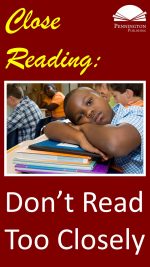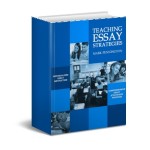The Reader, The Text, The Poem
Louise Rosenblatt developed the Reader-Response Theory, which posits that the reader’s personal feelings, knowledge, and experience contributes to the author’s text to create the meaning for the individual reader. Dr. Rosenblatt termed this creation of meaning “the poem.”
As theorists continued to work with her theory, they added the influence of the reader’s environment and social community as contributor’s to meaning.
In the New Criticism Movement of the 1950s, 1960s, and 1970s, critics of Rosenblatt asserted the independence of the text as the source of meaning. They argued that only the text should be the arbiter of itself. According to these critics and their cousins, the Formalists, devolving meaning-making to the reader was akin to admitting that the meaning of the text is anything that the reader makes of it.
I, personally, see a melding of the opposing theories as an important impetus to improving reading comprehension. If reading comprehension is the understanding and retention of text, then both the author’s text and the reader have shared responsibility for meaning-making. That meaning-making is not in the exclusive control of the text. After all, there is an author behind the text. It is also not in the exclusive control of the individual reader. The reader is part of a larger community.
To better explain the relationship of the author’s text and the reader in the creation of meaning, this illustration may be helpful.
Imagine sitting in your living room, looking at a garden through a window.
In our illustration, the garden is the author’s text; you, in the living room, are the reader; and the window is the meaning of the reading text. If the garden is closer to the window than you are, the author’s text has more control of or influence upon the meaning. If you are closer in the living room to the window than is the garden, you, the reader, have more control of or influence upon the meaning.
With author-centered texts, designed to inform, explain, and analyze, such as news articles, non-fiction, technical writing, legal text, and instruction manuals, the window is closer to the garden, because the reader’s comprehension is primarily text-dependent.
For example, with respect to the news article on the school shooting, we rely upon the expertise and accuracy of the news reporter to help us understand what happened. To put together a toy on Christmas Eve, we depend upon concise, step-by-step directions and a good picture on the box.
With reader-centered texts, designed to describe, entertain, or persuade, such as fiction, poems, editorials, social media posts, and songs, the window is closer to you, the reader in your living room. The input and filter of your personal feelings, knowledge, and experience are significant contributions to understanding the text.
For example, if you are listening to and reading the lyrics of Lennon and McCartney’s “With a Little Help from My Friends,” you, the audience, are intended to contribute meaning to the song. Some of the lyrics are intentionally ambiguous.
As the official Beatle biographer, Hunter Davies, explains, Lennon and McCartney struggled to come up with a lyric to answer their question: “What do you see when you turn out the light?” Lennon suggested “I can’t tell you, but I know it’s mine.” It fit the required number of syllables and rhyme scheme, and McCartney loved it because it could mean different things to different people.
So the type of text and the author’s purpose should have considerable impact upon how readers should understand and interpret the text. Good readers are flexible readers. They monitor their levels of comprehension while reading, according to their own purposes and the dictates of the text. When crucial facts or plot events are being delivered, they move the window close to the author; when less important description or tone are being read to evoke a certain mood, they move the window closer to themselves as readers.
And one last comment about applying the author-reader relationship theories: For those of you accustomed to reading on automatic pilot, you may be looking at the garden for far too long without thinking of the window. For many of you, the window is in fine shape, but it may need a bit of Windex to make the garden more visible. We often become accustomed to dirty windows and don’t notice until someone scribbles “Wash me!” However, our attention needs to be drawn to the window before we can notice. How do we start paying attention? Check out Talking with the Author.
FREE DOWNLOAD TO ASSESS THE QUALITY OF PENNINGTON PUBLISHING RESOURCES: The SCRIP (Summarize, Connect, Re-think, Interpret, and Predict) Comprehension Strategies includes class posters, five lessons to introduce the strategies, and the SCRIP Comprehension Bookmarks.
Get the SCRIP Comprehension Strategies FREE Resource:
![]()

The Science of Reading Intervention Program
The Science of Reading Intervention Program: Word Recognition includes explicit, scripted instruction and practice with the 5 Daily Google Slide Activities every reading intervention student needs: 1. Phonemic Awareness and Morphology 2. Blending, Segmenting, and Spelling 3. Sounds and Spellings (including handwriting) 4. Heart Words Practice 5. Sam and Friends Phonics Books (decodables). Plus, digital and printable sound wall cards and speech articulation songs. Print versions are available for all activities. First Half of the Year Program (55 minutes-per-day, 18 weeks)
The Science of Reading Intervention Program: Language Comprehension resources are designed for students who have completed the word recognition program or have demonstrated basic mastery of the alphabetic code and can read with some degree of fluency. The program features the 5 Weekly Language Comprehension Activities: 1. Background Knowledge Mentor Texts 2. Academic Language, Greek and Latin Morphology, Figures of Speech, Connotations, Multiple Meaning Words 3. Syntax in Reading 4. Reading Comprehension Strategies 5. Literacy Knowledge (Narrative and Expository). Second Half of the Year Program (30 minutes-per-day, 18 weeks)
The Science of Reading Intervention Program: Assessment-based Instruction provides diagnostically-based “second chance” instructional resources. The program includes 13 comprehensive assessments and matching instructional resources to fill in the yet-to-be-mastered gaps in phonemic awareness, alphabetic awareness, phonics, fluency (with YouTube modeled readings), Heart Words and Phonics Games, spelling patterns, grammar, usage, and mechanics, syllabication and morphology, executive function shills. Second Half of the Year Program (25 minutes-per-day, 18 weeks)
The Science of Reading Intervention Program BUNDLE includes all 3 program components for the comprehensive, state-of-the-art (and science) grades 4-adult full-year program. Scripted, easy-to-teach, no prep, no need for time-consuming (albeit valuable) LETRS training or O-G certification… Learn as you teach and get results NOW for your students. Print to speech with plenty of speech to print instructional components.
Literacy Centers, Reading, Spelling/Vocabulary, Study Skills







